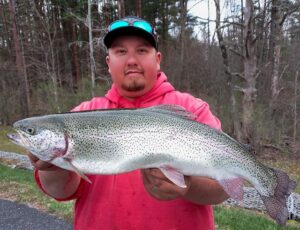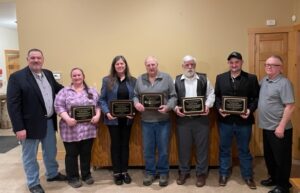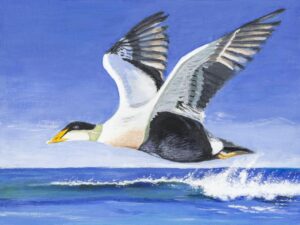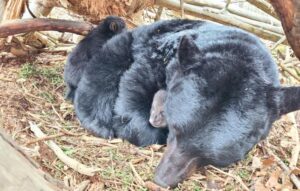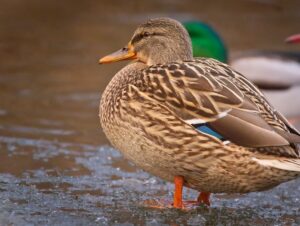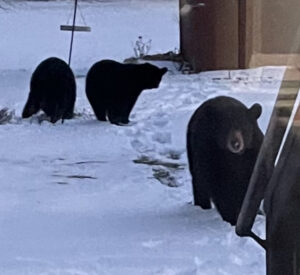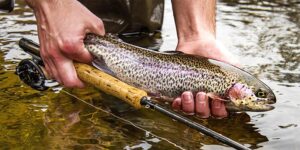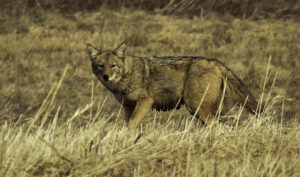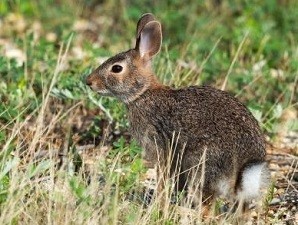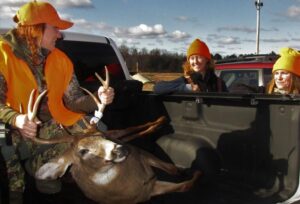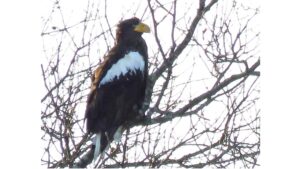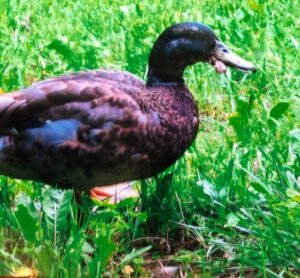The leaping brook trout license plate has been available to motorists since 1998, and has provided funding for grassroots conservation efforts through the Massachusetts Environmental Trust (MET) for many years. Thanks to a new agreement, the plate now also provides funding for the Division of Fisheries and Wildlife (MassWildlife) to target high-priority restoration efforts in trout streams.
Eastern brook trout, the only type of wild trout native to Massachusetts, are listed as a Species of Greatest Conservation Need in the Massachusetts State Wildlife Action Plan and require cold, clean water to thrive. Brook trout are an important recreational resource for anglers, and their presence is considered an indicator of high-quality coldwater habitat. Unfortunately, wild trout in Massachusetts are at risk from warming water temperatures, changes in stream flow, and disruptive human activities on the landscape, like dams and culverts that block their movements.
“The conservation projects funded through the brook trout license plate will complement and advance MassWildlife’s existing efforts to manage and restore coldwater habitats in Massachusetts,” said Todd Richards, MassWildlife’s Assistant Director of Fisheries. “As climate change and habitat degradation increasingly threaten habitats for wild trout and other coldwater species, it’s more important than ever to bring together partners to conserve these resources.”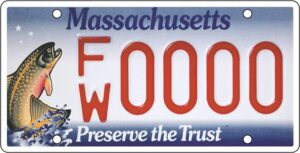
Half of the proceeds will go directly to MassWildlife for the conservation and management of coldwater fishery resources, while the remaining funds are distributed through a grants program to other conservation partners that are engaged in management activities that benefit brook trout and their habitats. Funds will be directed to high-priority projects, like those developed to restore habitats and improve fish passage, improve knowledge of coldwater fisheries ecology, and address emerging issues such as climate change.
“The Massachusetts Environmental Trust is pleased to continue and refine its partnership with the Division of Fisheries and Wildlife on the Brook Trout license plate,” said R.J. Lyman, Chair of the Massachusetts Environmental Trust. “The Trust has always focused its funding on public and non-profit initiatives to protect threatened species and critical habitats, in marine, estuarine, and fresh water resource areas. More plates mean more protection!”
The plate is available through the Registry of Motor Vehicles to all motorists who are registering a vehicle in the Commonwealth. For motorists who already have a vehicle registered and want this plate, they can visit Mass.gov/myRMV to order one. Like all specialty plates, the cost to the motorist is $40 every two years, in addition to the cost of a standard passenger plate every two years. MET also offers other specialty environmental plates including the striped bass plate, the right whale plate, and the Blackstone Valley plate.
Trout Stockings
The following waters were stocked with trout the week of May 9- 13: Trout Brook in Worthington and Peru, Wahconah Falls Brook in Dalton, Windsor Brook in Windsor and Hinsdale, Green River in Alford, Egremont and Great Barrington; Clam and Buck Rivers in Sandisfield, Town Brook in Lanesborough, Hoosic River in Cheshire and Adams, Yokun Brook in Lenox, West Brook in in Lee and Great Barrington, Sackett Brook in Dalton and Pittsfield, Larrywaug Brook in Stockbridge, Greenwater Brook, Goose Pond Brook and Beartown Brook in Lee; Konkapot River in Monterey and New Marlborough, Housatonic River (C&R) in Lee and Stockbridge, Little River in Worthington and Huntington, Westfield River in Huntington, Littleville Lake in Huntington and Chester, Ashfield Pond in Ashfield, Windsor Pond in Windsor and Onota Lake in Pittsfield
Waters scheduled to be stocked during the week of May 16 – 20: Clesson Brook in Ashfield and Buckland, West Branch of the Westfield River in Becket, Middlefield, Chester and Huntington; East Branch of the Westfield River in Windsor, Cummington and Chesterfield, North Branch of the Hoosic River in Clarksburg and North Adams, Chickley River in Charlemont and Hawley, Cold River in Florida and Charlemont, East Branch of the Housatonic River in Hinsdale and Dalton, Southwest Branch of the Housatonic River in Pittsfield, Green River (North) in New Ashfield and Williamstown, Plunkett Reservoir in Hinsdale, Norwich Pond in Huntington, Goose Pond in Lee and Tyringham, Laurel Lake, Otis Reservoir and Richmond Pond.
Good showing at the Beagle Club Field Trials
On April 23 and 24 the Berkshire Beagle Club held an American Kennel Club (AKC) sanctioned field trial on its land in Richmond, MA. Contestants from PA, NY, MA, VT, NH, CT and RI participated in the two-day event. According to Club Secretary Patrick Barry, it was one of their biggest field trials. They had 43 entries on Saturday and 75 entries on Sunday, for a total of 118 hounds
Males ran on Saturday and females on Sunday. Classes were further identified as 13-inch and 15-inch beagles. Awards were given for first through fourth places as well as NBQ (next best qualifier).
Ralph Harrington of Cambridge, New York, who is a Berkshire Beagle Club member, took home a blue ribbon. Or, I should say his 13-inch 2 ½ year old male named Ralph’s Copper City Eaton Stew (pictured) did. Quite an accomplishment when you consider the stiff competition that was there that day. According to Ralph, his handsome beagle has also placed in other field trials recently.
Pictured with Ralph and to his left is Scott Bisbee and Bob Kane, Jr.to his right. Both are field trial judges
Ralph also commented that it was a nice event with good food and good judges.
He’s at it again
Joshua Christman of Pittsfield, who has been named Massachusetts Angler of the Year (Adult Catch and Keep Category) in 2016, 2020 and 2021 by MassWildlife and a frequent multi-gold pin awardee is off to another good start this year. Check out the huge rainbow trout which he caught recently out of Berkshire County waters. It measured 24 inches long and weighed 4 lbs.
It looks bigger, ey?
Dept of Fish & Game/ Army Corps of Engineers Agreement
Last month, at the Silvio O. Conte Awards Banquet, which was held at the Cheshire Rod & Gun Club, Ron Amidon, Commissioner of MA Department of Fish & Game Department (DFG), was called upon to say a few words. He didn’t plan on speaking, but I think you would be interested in what he did say in his short speech.
About 4 years ago DFG started negotiations with the Army Corp of Engineers (ACOE). DFG owns land that abuts the ACOE in a lot of locations, but one of the locations that has the most land (8,000 acres) is called Birch Hill Dam of Central MA that ACOE owns. The Division of Fisheries and Wildlife (DFW) and the Department of Conservation and Recreation (DCR) have a lot of abutting land. If one puts those 3 landowners together, there’s almost 14,000 acres of open, conserved land.
Most people agree that the DFW and DCR are doing a good job of managing their lands but the ACOE will be the first to admit that they do not. They acknowledge that land management is not what they do, but rather flood protection. According to Amidon, the ACOE in effect asked the DFE to manage their lands. After 2 ½ years of negotiations, an agreement was signed. DFW will get to manage the ACOE land and, they get to keep the money for up to 5 years as long as they put that money back into the management of those lands. That includes prescribed burns, invasive species control and improvement of the roads.
Amidon believes that is the first license agreement with the ACOE in the entire northeast and perhaps in the country in terms of pilot programs. So, all of the other areas where they (DFG/DCR) own land that abuts land owned by the ACOE, such as the Knightsville Dam area are being looked into with the hopes of coming to similar management agreements.
Amidon discussed other interesting projects which we hope to get into in future columns.


